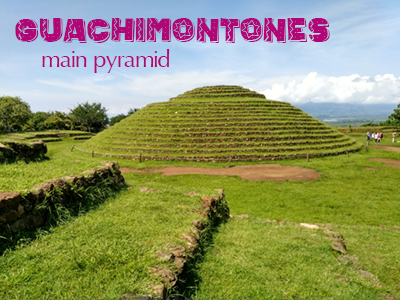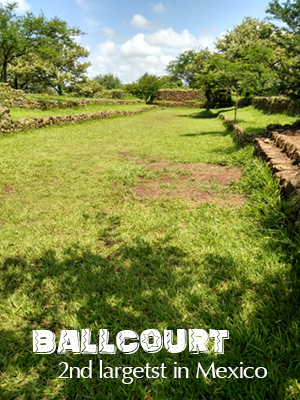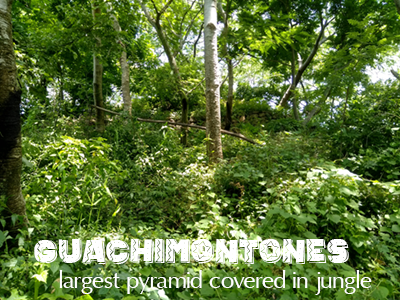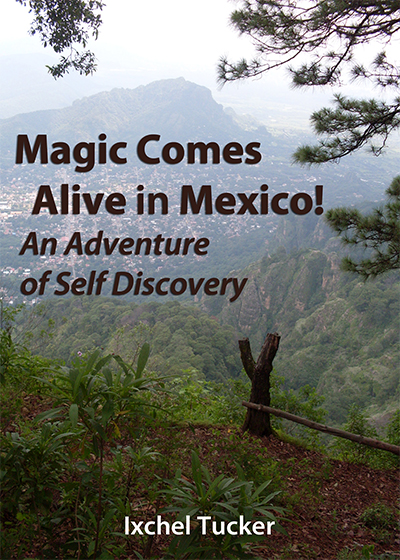Guachimontones: Circular Pyramids near Guadalajara
 Guachimontones is a tongue twister. It’s easier to remember if you break it down. “Guachi” was for a local type of fruit tree growing on the site. “Montones” means mounds. So, it basically means mounds where the fruit trees grow.
Guachimontones is a tongue twister. It’s easier to remember if you break it down. “Guachi” was for a local type of fruit tree growing on the site. “Montones” means mounds. So, it basically means mounds where the fruit trees grow.
My first trip to Guadalajara was only for one day / two nights, on an extended layover to Mexico City. I’d never been there. When I booked my room, an Airbnb, I had no idea what to see on my trip, just that there was a beautiful cathedral, I’d seen it in photos, but that’s where my knowledge stopped.
My host recommended Guacimontones, among a few other ideas, like Tequila (the town, not the booze, but where the booze comes from) and Ameca, where coffee is made. For me it was an easy choice. Liquor and coffee don’t interest me, but I love visiting pyramids. Every site is different, even in the same culture. And there are so many different cultures, beyond the Aztecs, Olmecs and Mayans, more that most people have heard of. I choose pyramids every chance I get.
My day at Guachimontones brought unexpected surprises. There was no easy way to visit the site without a car. There’s no bus service to the area, my usual form of transport in Mexico. It was about an hour from Guadalajara and a taxi would be expensive. So I splurged a bit and signed up for an Airbnb Experience “Guachimont Ancestral Pyramids” for only $45 USD. Our day trip included transportation from Guadalajara and the entrance fee. Alejandro, our 5-star guide, even supplied bottled water and fruit to snack on.
From Guadalajara he drove us out of town on Highway 15 towards Puerto Vallarta (only 4-5 hours away, though he said traffic can be a crawl on a busy weekend like Semana Santa). Guachimontones is about an hour from Guadalajara, a little past the turnoff for Tequila, with Ameca a bit further down the road. Alejandro (or Alex) pointed out a large bioreserve as we drove by called Bosque de la Primavera. He told us there are water parks and ecotourist attractions in the reserve.
 After a while we came to a lake and Teuchitlan, a small colorful colonial town of about 8,000. It is not one of the 120+ Pueblo Magicos, but it had me enchanted.
After a while we came to a lake and Teuchitlan, a small colorful colonial town of about 8,000. It is not one of the 120+ Pueblo Magicos, but it had me enchanted.
Alejandro (or Alex) was friendly and full of information, telling us about the Guachimontones in both English and Spanish. We learned that this site wasn’t truly discovered until the 1970’s. Before that it was thought there were only small groups of people in the area. But with this discovery it became clear that a much larger civilization existed.
They have since found over 400 smaller sites in the region, all with the same characteristics: Circular pyramids surrounded by square temples. It was clear they are part of the same culture. Another feature unique to these people were deep tombs used for the ruling class, accessed by a tunnel. And the people of the ruling class were large and tall, very different from the smaller Mexican indians that were found in the burials of the working class.
Still, there isn’t much known about these people. The traditions and stories haven’t been passed down and this site was abandoned around 900 CE. But it is speculated that these tall people came from the North.
The evidence shows that they traded throughout Mexico and North America. The tombs contained blue jade from the Yucatan, turquoise from Arizona, shells from the sea, and various other precious stones, along with the local obsidian from the Tequila Volcano that rises behind the site.
The volcano has one of the largest deposits of obsidian in Mexico. It gave the tequila drink its name, as the obsidian blades were used to cut the agave. The fermented agave drink goes back hundreds of years as well. Traces of tequila have been found in ancient vases at the site.
 I was fascinated. Guachimontones is so different from others I’d seen. After touring the small museum at its base we climbed the road to the pyramids, coming first to one of the ball courts. There are four ball courts on the site, two for formal games and two for practice. The ball courts were different from other cultures as well. Archeologists have found no evidence of the usual hoops that the ball was shot through. They have hypothesized, instead, that perhaps the game was more like our football, getting the ball from one end of the court to the other. They also couldn’t tell if these people sacrificed the opponents, the common practice in other parts of Mexico.
I was fascinated. Guachimontones is so different from others I’d seen. After touring the small museum at its base we climbed the road to the pyramids, coming first to one of the ball courts. There are four ball courts on the site, two for formal games and two for practice. The ball courts were different from other cultures as well. Archeologists have found no evidence of the usual hoops that the ball was shot through. They have hypothesized, instead, that perhaps the game was more like our football, getting the ball from one end of the court to the other. They also couldn’t tell if these people sacrificed the opponents, the common practice in other parts of Mexico.
Yet it is interesting that so much of the other Mesoamerican cultures was common to the Guachimontones, for instance, even having a ball court. The ball courts here are unique in other ways. The walls are low, whereas at other sites they are high, perhaps to help keep the ball within the playing area. None of the actual balls were found, though being made of rubber, they probably wouldn’t pass the test of time.
After the ball court, it wasn’t much further to walk to the main pyramid. This was a circular pyramid with thirteen steps, leveled out slightly, and then another four steps to the top. It’s surrounded by ten square bases that were originally topped with wooden temples. The unusual thing here is that the pyramid wasn’t the temple, they did not place a temple on top in the way the Mayans, Aztecs, and others did. The temples surrounded it.
Everything was circular, with some circles interlocking and sharing common sides, like cogs on a geared wheel. Some of the pyramids were small, others medium sized, and a few large. This first pyramid we came to is the second largest on the site, but it wasn’t large. The pyramids here are not nearly as big as those of Teotihuacan or Cholula.
Yet, even though second in size at this site, the main pyramid was obviously an important one. There is evidence of a connection to the God of Wind, Ehecatl. They have also found that this site had a practice similar, but different, to the voladores of Papantla. At the top of the pyramid is a post hole for a pole that appears to have been used for a sacred practice where the priest or shaman would climb the pole and hold a flying position, with arms out like wings.
Even this evidence is guessed at. Their only recorded information was in the form of clay sculptures. The sculptures depicted their daily life. They showed groups of people in various situations: one showed the ball game, another a group dance, and another showing the pole and the “volador” (meaning flying one) at the top.
 The views from the site are incredible. I was lucky to visit in the rainy season so everything was lush and green. The pyramids are situated on a hill and look down over the valley at a lake, Lago de la Vega, below. You can also see the small town of Teuchitlan, the town we drove through to get to the pyramid site.
The views from the site are incredible. I was lucky to visit in the rainy season so everything was lush and green. The pyramids are situated on a hill and look down over the valley at a lake, Lago de la Vega, below. You can also see the small town of Teuchitlan, the town we drove through to get to the pyramid site.
Aerial photography has shown placement of the circular pyramids and even helped identify those yet unexcavated. It has also shown that floating islands, called Chinampas, were used on the lake to grow their crops.
After exploring the main pyramid and a smaller one on the side, we went up through the larger ballcourt that sits behind it. This ballcourt is one of the longest in the country, topped only by the ballcourt at Chichen Itza. Again, there is no information to know more of what the games were like here. However, archeologists have discovered over 100 skulls, with their hands, in two burials on the site, adding to the likelihood that there was some sort of ritual sacrifice.
 On the far side of the ballcourt we came to the largest of the pyramids. This one is not excavated and instead covered in jungle. It made me wonder how these pyramids were ever discovered. It simply looked like a hill or mound of jungle.
On the far side of the ballcourt we came to the largest of the pyramids. This one is not excavated and instead covered in jungle. It made me wonder how these pyramids were ever discovered. It simply looked like a hill or mound of jungle.
Our guide, Alejandro, explained that they can’t excavate this pyramid due to all the damages caused by time, looting of the site, and missing stones. Because the Guachimonotones site was discovered so late in time, many of the stones were appropriated for building churches and cathedrals. They have even found stones from the site with pictographs in some local churches.
Instead, we were able to see and climb to the top of this pyramid in its wild form, covered by nature. Tall trees, vines and shrubs surrounded and covered it. A stone path and steps took us to the top. The bonus here was having the shade at the top of a pyramid, which you just can’t get on a cleared and restored site.
We could see all the way across the lush valley to mountains on the other side. Alejandro showed us that the main pyramid in front of us lined up with a rounded hill on the other side of the valley, just under the mountain, that appeared equally round to the pyramids at this site. He didn’t know if anything had been discovered there and it leaves me wondering if this was another pyramid or just a hill they were lining up with. If it’s a pyramid it would have to be even bigger than those of Guachimontones.
There is so much more I could write about this ancient civilization. I have only scratched the surface. It seems to have taken hold of me with a curiosity to learn more.
But by now it was time to go get some lunch. We stopped at one final pyramid, this one was square, still surrounded by other square temples. Alex said the theory was this was the last one built, and possibly it was square because it was built by conquerers of the people. However, the main theory is that the people of this site moved on as their civilization grew too big to be supported by the food in the area.
For lunch we headed back to the van and Alex took us down to the Monte Carlo Restaurant, right on the lake. We were treated to views of water lilies and white cranes, and a menu of seafood and fish. I choose a plate of moharra, a local river fish. It was light and delicious, a beautiful end for our day together.
Finding your way …
What to Expect
Guachimontones is a small site. Entrance fees and hours shown were effective 3/19/2020.
Entrance Fee: $30 pesos (approx. $1.50 USD)
Hours: Tuesday to Sunday from 9:00 a.m. to 5:00 p.m.
The site is located approx. one hour from Guadalajara. The site is located one kilometer northeast of the nearest town, Teuchitlán.
There are a places to eat in Teuchitlán. I recommend the Monte Carlo Restaurant on the lake for local fish and seafood. It is just off the main highway as you leave town.
Getting to the Guachimontones
Sign up for a Tour: Guachimont Ancestral Pyramids
Drive from Guadalajara: 1 hr by car
There are no local buses from Guadalajara to Guachimontones.
Local guides may provide service and transportation. Check Airbnb Experiences or a Google Search. At the time of this publication the Airbnb Experiences did not show any listings for Guachimontones or Guadalajara, but things change quickly and often in Mexico.
This is one place it could pay off to rent a car directly at the airport, if you are flying in. Since the airport is about a half hour from Guadalajara, taxis even into the center may cost more than a cheap car rental.
Side Trips
Tequila
Tequila (and the local area around Jalisco) is the only place you can get true Tequila. The town sits near the foot of the Tequila Volcano. You will see fields of blue agave, the liquor’s main ingredient, dotting the landscape. Go here to observe the local distilleries and haciendas. The Museo Nacional del Tequila and the Museo Los Abuelos feature exhibits on the history of the drink. Learn more at Visit Mexico.
Airbnb Tours with Alejandro: Volcanoes, Pyramids, Agaves & Tequila

